The size of the tertiary student population is an indicator of the accessibility of tertiary education. It is also a key determinant of the levels of human capital that will be available to the New Zealand labour force.
The purpose of this report is to note the influence of projected population change on the tertiary education system. It comments on the implications of demographic change for the size and make-up of the tertiary student population, the network of public provision and, to a lesser extent, on the levels of human educational capital the tertiary system produces.
Purpose
This paper comments on some of the possible consequences for the size and make up of the tertiary student population of changes in the New Zealand population over the next two decades – changes in the ethnic diversity, age composition and regional distribution of the population
Key Results
- The rate of growth in tertiary students will slow significantly from that experienced in the peak growth period of 1999 and 2004. The size of the tertiary student population will peak in 2016 with around 483,000 domestic students - an increase of 6 percent over that of 2005, before decreasing slightly to 480,000 in 2021. People aged 40 years and over will comprise over half of all growth in domestic student numbers between 2005 and 2014.
- Demand for sub-degree tertiary education will continue to dominate growth in student numbers (72 percent of all growth). The expected bulge in the population aged 18 to 24 years will, however, lead to record numbers of students studying at bachelors degree-level in the short term. But the proportion of the tertiary student population studying at this and higher levels will then decrease.
- Students of European ethnicity are expected to decrease from 65 percent of all students to 57 percent between 2005 and 2021, while there will be relatively more Māori, Pasifika, and most noticeably, Asian students - who will comprise 16 percent of all students by 2021.
- Analysis of school leaver attainment predicts a diminishing proportion of school leavers with a university entrance qualification. This trend occurs as a result of changes in the ethnic composition of the school population and despite slight improvements recently in school achievement levels for each ethnic group.
- Population change may have implications for providers with a strong regional focus. In many cases, the population of the areas in which an Institute of Technology and Polytechnic (ITP) is present is decreasing out to 2026. Of the 56 ITP campuses spread throughout New Zealand , there is expected to be population decline among people aged 15 to 39 years in the areas of 37 campuses and among people aged 40 to 64 years for 26 campuses. Implications of local population decrease will be further compounded in areas where there are multiple tertiary education providers.
- It is expected that the outflow of young educated people that has always occurred will continue but that it may recede slightly over the next three years. In conjunction with this, if the gains in educated migrants of recent years are sustained, then the ‘brain gain’ experienced over the last census period could continue. Also, given the number of bachelors degree qualifications attained in the coming years, New Zealand ’s human education capital, as measured by those people with a degree, will continue to increase.

